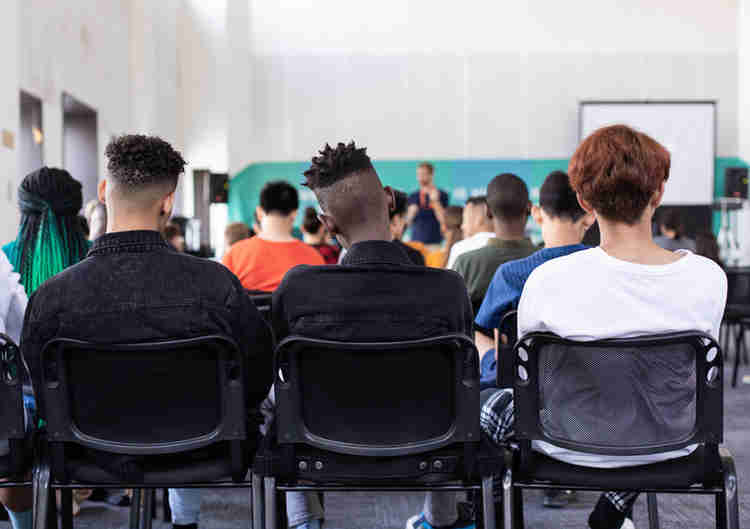To be called the n-word is an unfortunate yet inevitable rite of passage for Black children. Most of us can remember the first time it was called to us. I also remember the first time my child was called the n-word. A classmate approached them and asked them to finish this sentence, “I like salt and vi-”, to which my child responded “negar?” There was giggling then laughter, but not from my child.
For those who did not learn the n-word from the mouths of their classmates, parents or other family and friends, they became acquainted with the term in their classrooms. In English literature, teachers have gravitated to the “classics” that depict Black people as criminals, savages and unintelligent, reducing Black people to this six-letter word. In studying these books, students have complained here, here, here, here and here of the unfiltered manner in which teachers and professors repeat the n-word. To these students, the use of the word is harmful, traumatic and hateful. To those teaching the word, it is a form of pedagogy and academic freedom.
The recent scandal in which a university professor used the n-word has re-ignited a debate about the n-word and academic freedom. Written petitions have circulated in support of the professor, and both white and Black academics have defended the professor. Even the Premier of Quebec, François Legault has weighed in, commenting that, “in places like universities, you have to be able to have a debate about everything.”
What is missing from this debate, and what has always been a gaping hole in discussions about when it is appropriate to use the n-word, is context: the context of using the n-word in a curriculum, education system, and society which centers whiteness, and in doing so, silences and vilifies what it means to be Black.
Black people, their stories and contributions have been left out of the curriculum. History lessons about Confederation, the world wars, the Great Depression have been framed from the perspective of white experiences. The stories of enslavement, the Black Battalion, residential schools were absent in textbooks and lessons. A recent campaign by The Ontario Black History Society, #Blackedouthistory, demonstrates how absent Black history is in the curriculum. The Society blacked out a Grade 8 history textbook, except where there is reference to Black history. Of the 255 pages in the textbook, there were only 13 pages left.
In Contemporary Studies when we learned about feminism, we celebrated Nellie McClung and the Famous Five who fought for women to be recognized as persons under the law. We did not learn that among the Famous Five, feminism was limited to white, Anglo-Saxon and Protestant women. We did not learn about the racist views espoused by some of the Famous Five towards Chinese, Black and other racialized people. According to the Globe and Mail, Emily Murphy, wrote:
One becomes especially disquieted — almost terrified — in the face of these things for it sometimes seems as if the white race lacks both the physical and moral stamina to protect itself, and that maybe the black and yellow races may yet obtain the ascendancy.
In English Literature, from a young age children are introduced to racist books and narratives. Children’s classics like the Cat in the Hat that is said to be based on blackface minstrelsy, and the Tintin series that contains racist depictions of African and Indigenous people, have been a staple in classrooms, libraries and bedrooms for decades. In high school, the few times we learn about Black people is in English literature where Othello, Heart of Darkness, To Kill a Mockingbird, Tom Sawyer, and The Adventures of Huckleberry Finn are on class reading lists year after year. These books reduce Black identities to a level of inferiority that is inauthentic, invalidating and racist.
We then need to think of the student who navigates 14 years of elementary and secondary education with very limited exposure, if at all, to Black people, history, and culture. They are likely to develop a narrow understanding of what it means to be Black, relying on racist stereotypes and an incomplete perspective to inform their understanding of, and relationship to Black people. These are individuals who become politicians, policy makers, educators and university professors.
We also have to think of the Black students who navigate a school system where they are often the only ones in the classrooms where the n-word is repeated; where their educators share a different lived experienced from them; and where they must internalize a curriculum that does not reflect who they are as individuals and as a people. Black students become invisible and when they complain about the harm of the n-word, in this much broader context, they continue to be silenced at the expense of academic freedom.
We need to think more critically about the use of the n-word and the harm it causes. Below we offer some points for reflection when teaching material that contains the n-word:
- As educators and academics, it is important to reflect on your social identity, what it means as a white person teaching material that contains the n-word. In her book, White Fragility, author Robin DiAngelo describes how “white children develop a sense of white superiority as early as preschool … as society sends constant messages that to be white is better than to be a person of colour” (pg. 47). Consider how you have been socialized, how you have internalized ideas of Black people through your learning in school and at home.
- As an educator, how are Black people represented in your course, if at all? Do you provide narratives of Black people that are positive and affirming? Or do you tend to use materials that reinforce stereotypes and other negative messages about Black people?
- What does an inclusive curriculum mean to you? Do books like To Kill a Mockingbird, Heart of Darkness or Othello promote an inclusive curriculum? What does it mean to amplify the voices of writers who do not reflect the lived experiences of Black people? Consider the rich narratives of Black writers like James Baldwin, Richard Wright, Esi Edugyan, and David Chariandy. Should we not be incorporating their voices?
- When teaching literature or content that includes the n-word, refrain from using the actual term. Your intentions may be sincere and you may feel you are just repeating what is included in the text, but your use of this term will cause harm to the Black student in your class, as well as to other students who then think it is appropriate to repeat this language.
- Think about the student in front of you: are you teaching to predominantly white students? If there are a few Black students in the course, what impact does it have on them to read materials that contain the n-word? Without seeking their perspectives, consider doing research on the impact of using the n-word when you teach.
- Provide a history lesson of the n-word, how it came into conception and how it has been used as a way to denigrate Black people. Provide perspectives, like the one offered by James Baldwin about what the n-word means. Examine the desire by some to use the word in the broader context discussed above.
- When weighing the issue of academic freedom, consider the right for all students to receive an education that is free from discrimination. Academic freedom is not absolute, nor should it ever be invoked to invalidate and traumatize students.
Want to learn explore more about anti-racist teaching in English literature and contemporary studies? Register here for our next webinar.







I really like it when folks come together and share opinions.
Great website, stick with it!
No.
It is triggering and reinforces stereotyping as well as bullying in the halls and washrooms.
It should not be sounded in the classroom – elementary, secondary or post secondary.